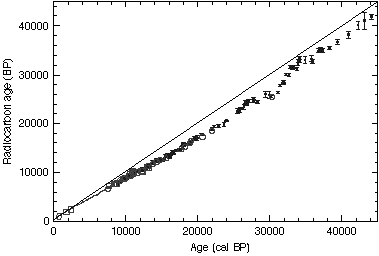Similarly, an obvious indicator of catastrophism is the existence of fossils in the sedimentary rocks. The depositional processes must have been rapid, or fossils could not have been preserved in them.
"To become fossilized, a plant or animal must usually have hard parts, such as bone, shell, or wood. It must be buried quickly to prevent decay and must be undisturbed throughout the long process."5
The importance of this fact is obvious when one realizes that the identification of the geologic "age" of any given sedimentary rock depends solely upon the assemblage of fossils which it contains. The age does not depend on radiometric dating, as is obvious from the fact that the geologic age system had been completely worked out and most major formations dated before radioactivity was even discovered. Neither does the age depend upon the mineralogic or petrologic character of a rock, as is obvious from the fact that rocks of all types of composition, structure, and degree of hardness can be found in any "age". It does not depend upon vertical position in the local geologic strata, since rocks of any "age" may and do rest horizontally and conformably on rocks of any other age. No, a rock is dated solely by its fossils.
"The only chronometric scale applicable in geologic history for the stratigraphic classification of rocks and for dating geologic events exactly is furnished by the fossils. Owing to the irreversibility of evolution, they offer an unambiguous time-scale for relative age determinations and for world-wide correlation of rocks."6
Thus, the existence and identification of distinctive geologic ages is based on fossils in the sedimentary rocks. On the other hand, the very existence of fossils in sedimentary rocks is prima facie evidence that each such fossiliferous rock was formed by aqueous catastrophism. The one question, therefore, is whether the rocks were formed by a great multiplicity of local catastrophes scattered through many ages, or by a great complex of local catastrophes all conjoined contemporaneously in one single age, terminated by the cataclysm.
The latter is the most likely. Each distinctive stratum was laid down quickly, since it obviously represents a uniform set of water flow conditions, and such uniformity never persists very long. Each set of strata in a given formation must also have been deposited in rapid succession, or there would be evidence of unconformityâ€â€that is, periods of uplift and erosionâ€â€at the various interfaces.
Where unconformity does exist, say at the top of a formation, there may well have been an interval of uplift or tilting, at that location. followed by either sub-aerial or sub-marine erosion for a time. However, since such formations invariably grade laterally into other formations (no unconformity, is worldwide), sooner or later one will come to a location where there is a conformable relationship between this formation and the one above it. Thus, each formation is succeeded somewhere by another one which was deposited rapidly after the first one ... and so on throughout the entire geologic column.
Thus, there is no room anywhere for long ages. Each formation must have been produced rapidly, as evidenced by both its fossils and its depositional characteristics, and each formation must have been followed rapidly by another one, which was also formed rapidly! The whole sequence, therefore, must have been formed rapidly, exactly as the Flood model postulates.
But, then. what about the geologic ages? Remember that the only means of identifying these ages is by fossils and fossils speak of rapid formation. Even assuming a very slow formation of these beds, however, how can fossils tell the age of a rock?
Obviously, fossils could be distinctive time markers only if the various kinds each had lived in different ages. But how can we know which fossils lived in which ages? No scientists were there to observe them, and true science requires observation. Furthermore, by analogy with the present (and uniformitarianism is supposed to be able to decipher the past in terms of the present), many different kinds of plants and animals are living in the present world, including even the "primitive" one-celled organisms with which evolution is supposed to have begun. Why, therefore, isn’t it better to assume that all major kinds also lived together in past ages as well? Some kinds, such as the dinosaurs, have become extinct, but practically all present-day kinds of organisms are also found in the fossil world.
The only reason for thinking that different fossils should represent different ages is the assumption of evolution. If evolution is really true, then of course fossils should provide an excellent means for identifying the various ages, an "unambiguous time-scale," as Schindewolf put it. Hedberg says:
"Fossils have furnished, through their record of the evolution of life on this planet, an amazingly effective key to the relative positioning of strata in widely-separated regions."7
The use of fossils as time-markers thus depends completely on "their record of evolution." But, then, how do we know that evolution is true? Why, because of the fossil record!
"Fossils provide the only historical, documentary evidence that life has evolved from simpler to more and more complex forms."8
So the only proof of evolution is based on the assumption of evolution! The system of evolution arranges the fossils, the fossils date the rocks, and the resulting system of fossil-dated rocks proves evolution. Around and around we go.
Henry Morris, Ph.D.
Hydraulic Engineering
President, ICR (Died Recently...see separate post)






